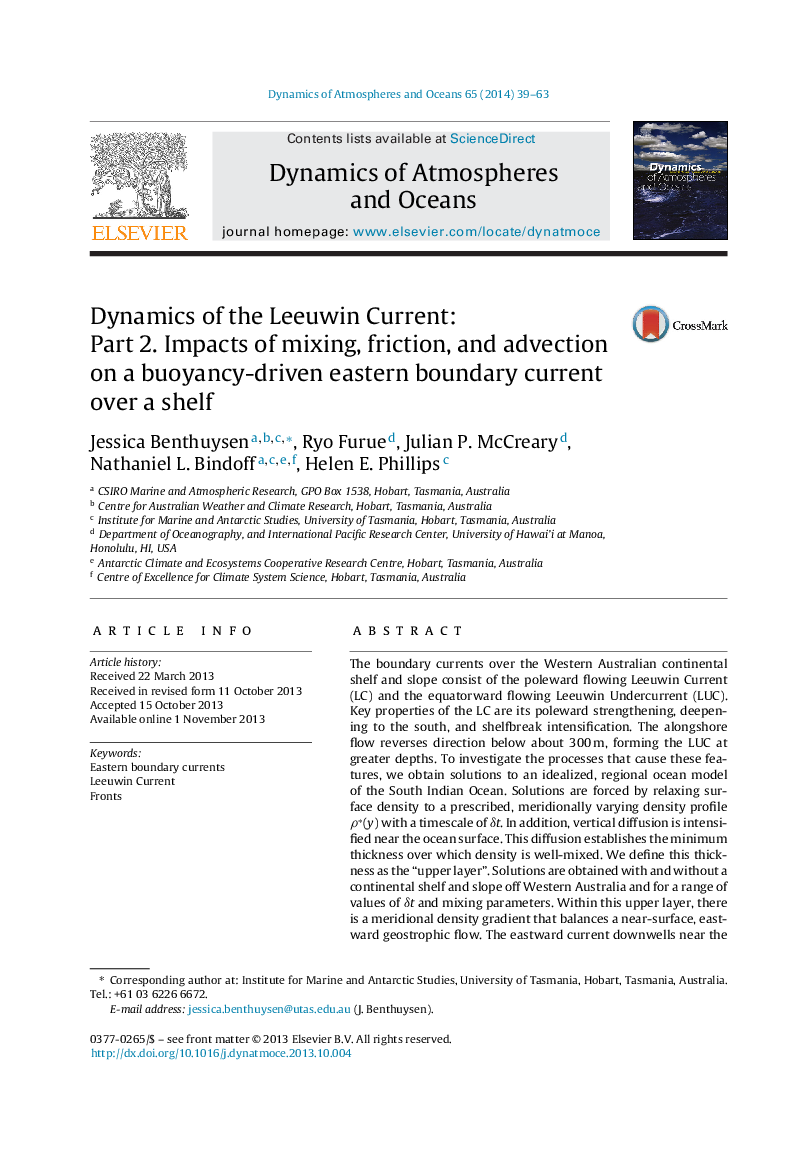| Article ID | Journal | Published Year | Pages | File Type |
|---|---|---|---|---|
| 6426536 | Dynamics of Atmospheres and Oceans | 2014 | 25 Pages |
â¢Shelf-slope topography traps Rossby waves and a poleward eastern boundary current.â¢Transport is controlled by the position where the pycnocline intersects the slope.â¢Mixing processes and bottom drag modify the current's speed and structure.â¢Buoyancy advection generates a shelfbreak front and jet and an undercurrent below.
The boundary currents over the Western Australian continental shelf and slope consist of the poleward flowing Leeuwin Current (LC) and the equatorward flowing Leeuwin Undercurrent (LUC). Key properties of the LC are its poleward strengthening, deepening to the south, and shelfbreak intensification. The alongshore flow reverses direction below about 300 m, forming the LUC at greater depths. To investigate the processes that cause these features, we obtain solutions to an idealized, regional ocean model of the South Indian Ocean. Solutions are forced by relaxing surface density to a prescribed, meridionally varying density profile Ï*(y) with a timescale of δt. In addition, vertical diffusion is intensified near the ocean surface. This diffusion establishes the minimum thickness over which density is well-mixed. We define this thickness as the “upper layer”. Solutions are obtained with and without a continental shelf and slope off Western Australia and for a range of values of δt and mixing parameters. Within this upper layer, there is a meridional density gradient that balances a near-surface, eastward geostrophic flow. The eastward current downwells near the eastern boundary, leading to westward flow at depth. The upper layer's meridional structure and zonal currents crucially depend on coastal processes, including the presence of topography near the eastern boundary. Kelvin waves inhibit the upper layer from deepening at the coast. Rossby waves propagate the coastal density structure offshore, hence modifying the interior currents. A comparison of the solutions with or without a continental shelf and slope demonstrate that topographic trapping of Rossby waves is a necessary process for maintaining realistic eastern boundary current speeds. Significant poleward speeds occur only onshore of where the upper layer intersects the slope, that is, at a grounding line. Its poleward transport increases when surface-enhanced vertical mixing is applied over a greater depth. When the timescale δt is sufficiently short, the poleward current is nearly barotropic. The current's spatial structure over the shelf is controlled by horizontal mixing, having the structure of a Munk layer. Increasing vertical diffusion deepens the upper layer thickness and strengthens the alongshore current speed. Bottom drag leads to an offshore flow along the bottom, reducing the net onshore transport and weakening the current's poleward acceleration. When δt is long, poleward advection of buoyancy forms a density front near the shelf break, intensifying poleward speeds near the surface. With bottom drag, a bottom Ekman flow advects density offshore, shifting the jet core offshore of the shelf break. The resulting cross-shelf density gradient reverses the meridional current's direction at depth, leading to an equatorward undercurrent.
